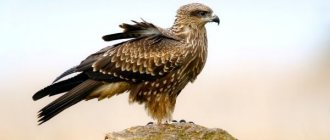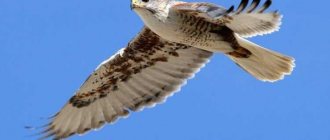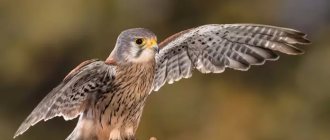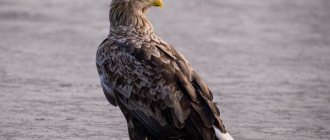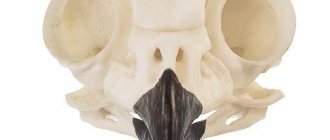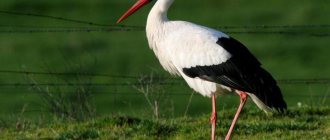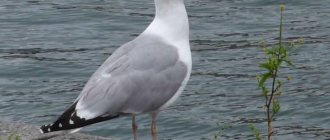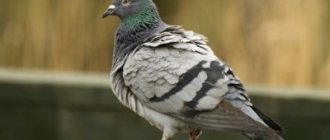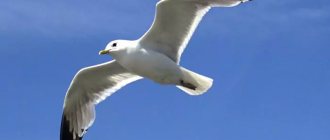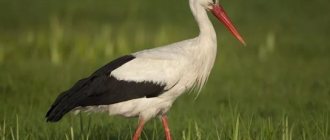Falcons are a genus of birds of prey that are widespread throughout the world. Their name comes from the word “falx” (“sickle”), thereby emphasizing the peculiar shape that their wings take during flight. It helps them achieve amazing success while maneuvering at high speed. For example, the peregrine falcon is considered the fastest bird in the world due to its ability to reach speeds of up to 320 km/h while chasing prey. Having discovered prey while gliding in the sky, it adjusts itself in such a way as to be slightly higher, after which it makes a rapid fall onto it, hitting it with its paws pressed to its body. Often the blow is so powerful that the victim dies instantly.
It is noteworthy that in Ukrainian culture the peregrine falcon has been called a falcon since the times of Kievan Rus, and only later did this name acquire a broader meaning, including other birds of this genus. It should be noted that even now, when speaking about falcons, people most often mean the peregrine falcon.
The peregrine falcon is a diurnal predator
The peregrine falcon is not only fast, but also a very strong bird, which has no equal among feathered predators. It is distributed almost everywhere, as it flies all over the globe. It can be found throughout Europe, both on rocky coasts and in areas with difficult climatic conditions. Most often, the peregrine falcon can be found in peat bogs, steppes and semi-deserts. These territories are his favorite places for recreation and hunting.
In Central Europe, these birds of prey inhabit predominantly mountainous areas, making their nests on steep cliffs. In winter, this falcon prefers to settle in close proximity to large bodies of water, where it hunts waterfowl. It is noteworthy that only young individuals are migratory, while older birds lead an exclusively sedentary lifestyle.
Where does the falcon live?
Falcons are characterized by a vast distribution range, which covers almost the entire Earth, excluding the polar regions. Some birds are natural nomads. Throughout their lives, they fly from one place to another, changing their habitat areas. Other species of falcons, on the contrary, prefer a sedentary lifestyle and choose a nesting place among the steppes and semi-deserts.
Other species of falcons, on the contrary, prefer a sedentary lifestyle and choose a nesting place among the steppes and semi-deserts.
Recommended by topic
Blackbirds Woodpecker Heron
In winter, young birds often move to warmer areas, while adult birds usually remain in their favorite areas. At the same time, they usually move closer to the water. Adult falcons calmly tolerate sharp drops in temperature and cold winter conditions. A decrease in food supply forces them to go out hunting more often. In winter, searching for prey becomes quite difficult, but the natural endurance of birds allows them to survive even in such conditions.
Representatives of different species of this family choose different regions and continents for their residence. Thus, the brown falcon typically lives in Australia and New Guinea, while the Mexican falcon lives in the desert regions of the USA and southern Canada. The Southern Mexican falcon, on the other hand, prefers grasslands and swamps throughout the United States.
The laughing falcon ranges from northern Argentina to southern Mexico. These birds typically live in tropical forests, among not too overgrown areas. The Mediterranean falcon chooses to live in the territories of Italy and the Balkans. Some representatives of this population also live in Africa and Asia Minor.
The pygmy red-footed falcon lives in open forest areas in the foothills of the Himalayas.
It chooses to live in areas where there are a large number of dry trees, not far from fields and meadows. Also, representatives of this species are sometimes found in the highlands of Vietnam or Nepal. They are able to live both on plains, near water sources, and at an altitude of about 800 meters above sea level.
Elena
Ask a Question
Question to the expert
What is the lifespan of falcons?
The average lifespan of birds in the wild is 15 to 20 years. In captivity, this figure can reach 30 years.
Appearance
The peregrine falcon is a bird of the falcon family, whose body length is 40-50 cm with a wingspan of 90 to 120 cm. It is noteworthy that males are almost half the size of females. The male weighs 650-800 g, and the female weighs 0.9-1.3 kg.
Most of the bird's body is dark gray. At the same time, dark triangular inclusions predominate in the plumage. The lower part of the chest and belly are pale yellow, with dark stripes. Even the black flight feathers are covered with spots. With its size, the peregrine falcon reaches the dimensions of a small crow, standing out among other birds of this genus with its dark, dark gray plumage of the back, variegated light belly, black top of the head, as well as dark, elongated spots under the eyes, called “whiskers”. Depending on the size and color characteristics, more than 15 subspecies of this falcon are distinguished. At the same time, three of them are common in the post-Soviet space:
- ordinary;
- Caucasian;
- tundra.
The first two are rare nesting birds, and the latter can only be seen during migration.
Falcon bird: description
Falcons are considered the fastest flying birds, as they can fly at speeds of more than 300 km/h. This hunter has excellent eyesight, as he is able to see his prey from a height of up to 1 kilometer inclusive. The shape of the falcon's wings in flight resembles a sickle, which formed the basis of its name in Latin.
Appearance
The falcon has strong and wide wings and a muscular body. The chest is wide and the limbs are powerful. The structure of the beak is very interesting, since it is short, in the form of a hook, in the upper part of which there is a sharp tooth. This feature makes it easy to break the spines of small birds. There is an unfeathered border around the eyes. The wings are powerful and massive, and the tail is long, rounded at the end. Adults differ from young ones in the structure of their flight feathers. Juveniles have short flight feathers, so in flight they use them all at once. In adult specimens, only the second feathers are flight feathers, but they are quite long.
This bird has the following characteristics:
- The length of the body is about 0.6 meters.
- The wingspan is within 1.2 meters.
- The tail is about 20 centimeters long.
- The size of the paws is about 5 centimeters on average.
- The length of the wing chord is about 40 centimeters maximum.
- Males weigh on average 0.8 kg, and females about 1.3 kilograms.
Interesting moment! Males are smaller than females, both in size and weight.
The birds are distinguished by a rather variegated body color, with a predominance of shades such as brown and gray. The plumage has a triangular pattern made in darker shades, although there may be splashes of white. You can see black spots on the flight feathers, and a black “cap” on the head. The feathers are pressed tightly against the body and have a rigid structure. This allows the falcon to develop significant speed. Among this diversity of the family there are almost white species, as well as almost black ones.
Behavior and lifestyle
Falcons prefer to hunt in the morning and evening hours, choosing small birds as prey. As a rule, they do not feed on carrion. To provide themselves with food, these predators use several hunting methods. They either catch their victims directly in flight, or dive from a height, finding potential prey on the ground. The rest of the time (during the day) the falcons are in their shelters and digest food. They build their nests on the tops of the tallest trees or on rocks. They can take over the nests of other birds, but they do this very rarely, since many birds nest in conditions unsuitable for falcons. These predators never build their nests on the ground.
Interesting moment! You can see how falcons in the sky demonstrate their capabilities, as if playing. At the same time, they can tease other birds of prey, as if demonstrating their advantage.
These predators can rise to heights that are inaccessible to other birds. After the formation of a couple, they protect their living space from attacks from the outside. The falcon bird, like many other representatives of this genus, prefers a nomadic lifestyle. Their migrations are associated not only with the search for places more comfortable for wintering, but also with the purpose of searching for food. Unlike other birds of prey, falcons are easily tamed by humans.
This predator is not afraid of humans and often settles next to humans. The hunting tactics of these predators are very entertaining. They attack their potential prey from above, after which they strike it with their powerful and sharp, hook-shaped beak. As a rule, one such blow is enough to kill any small bird.
They often deliberately lift their prey into the air in order to capture it in flight, while even fast swallows do not have time to react to the falcon’s attack. This is not at all surprising, since its speed at the moment of attack can reach more than 100 km/h. Sometimes you can see how the falcon plays with its prey, as if missing after the attack. In the end, the victim has no chance of survival.
It is important to know! Falcons are considered the most intelligent raptors among all birds of prey.
The bird is not afraid of humans and is easy to train. The training process consists of various elements, including both classes and games. In any case, it should be remembered that this is a formidable predator. Despite the fact that these birds get used to their owner, you should always behave carefully and carefully with them.
How long do falcons live?
It is believed that the average lifespan of these birds is within 15 and a half years, although some individuals live up to a quarter of a century. Naturally, being in the natural environment, birds live less than if they were kept in captivity.
Peregrine falcon (lat. Falco peregrinus)
Types of falcons with photos and names
The falcon family consists of 11 genera, with:
- There are 5 genera of caracaras, including black, red-throated, mountain, noisy and caracas.
- Falcons consist of 6 genera such as laughing, wood, American pygmy, small, pygmy and falcons.
The genus of falcons is considered the most numerous and basic. It consists of 40 subspecies, and they are divided into several groups, such as:
Kestrel
These are quite small birds, distinguished by a dense body and a red color. A gray variety of kestrel is found on the African continent. They prefer to hunt rodents. This species consists of 12 varieties.
Hobby
It is a large and slender bird, which is characterized by dark gray plumage, with black feathers in the cheek area. The bird is represented by five varieties.
Falcon
The most famous and most representative group, which includes: silver, evening, red-breasted, New Zealand, brown, gray, black, Mediterranean, Altai, Mexican and short-tailed subspecies.
Turumti
The ruby-necked falcon is distinguished by its medium size and the presence of a brick-red “cap” on its head. Found in India and the African continent.
Kobchik
Represents a small falcon that bears some resemblance to the kestrel, both in behavior and other characteristics. The weight of adults is about 200 grams. The falcon has a short and insufficiently powerful beak, so the diet of this bird consists of various large insects, such as grasshoppers, dragonflies, locusts and beetles. Prefers to nest in abandoned crow nests. It leads a gregarious lifestyle, with each flock containing up to hundreds of individuals. The bird also migrates as part of the entire flock.
Merlin
The habitat of this predator extends to northeastern Europe. The bird is small but stocky. It has short but sharp wings and a long tail. Prefers to settle within rivers and sphagnum bogs, while avoiding dense green spaces. The basis of the diet consists of small birds. It is considered a rather rare subspecies. The nests of this predator can also be found on the ground.
Laggar
This is a large bird that can be trained, so it is often used as a hunter of birds and other game, such as hares or ground squirrels.
Saker Falcon
The habitat of this species is represented very widely. It is considered a very dangerous species. The length of the saker falcon can be 0.6 meters, with a wingspan of almost one and a half meters. It is similar to the peregrine falcon, but differs in the shape of the wings and the color of the plumage.
Merlin
A rare bird, although it is considered the largest among its species. It is distinguished by long and sharp-shaped wings. The male weighs almost 1 kilogram, while the female weighs 2 times more. The gyrfalcon, compared to the peregrine falcon, has a longer tail. The habitat is associated with Europe, Asia and North America, although there is a subspecies found in Altai. It is considered a rare endangered bird, which is why gyrfalcons are included in the Red Book.
Peregrine Falcon
This predator is considered the fastest on our Planet. It is a classic representative of the falcon family. Its habitat is associated with many corners of our Planet, with the exception of Antarctica.
Shahin
It prefers to settle in desert areas, which is why it is often called the desert falcon. It is somewhat smaller in size compared to the peregrine falcon. The main color includes red and ocher tones. Adult males weigh about 350 grams, while females are 2 times heavier. Today it is an endangered species.
Interesting to know! The coat of arms of the state of Kyrgyzstan depicts a gyrfalcon, and the 500 tenge coin of Kazakhstan depicts a saker falcon.
Natural habitats
Representatives of the falcon family can be found without problems on almost all continents, except for the expanses of the north and south poles. Only young birds fly away for the winter, while older birds remain to winter in their previous territories, but at the same time move as close to water bodies as possible. Some species prefer to settle in steppes and semi-deserts. It is characteristic of gyrfalcons that they prefer coastal zones of northern latitudes. For the territory of Europe, the characteristic habitats of these predators are mountains and steep cliffs. Peregrine falcons are characterized by their nomadic lifestyle, which is why they can be found on any continent.
What does a falcon eat?
The falcon family eats objects of animal origin in the form of small birds, rodents, insects, etc., including frogs, snakes, and fish. In other words, the basis of their diet consists of warm-blooded animals, which are smaller in size compared to the predators themselves. Falcons are such skilled hunters that the prey has virtually no chance of escape if it comes into the falcon's field of view.
It is important to know! If the falcon is kept in captivity, then it will definitely have to be fed with game. Otherwise, the bird may become seriously ill.
Their digestive system is designed so that they need to eat everything, including feathers and small bones. Being in natural conditions, eating its prey whole, the bird provides itself with all the necessary nutritional components. Some time after eating food, the bird regurgitates the remains of food.
If the bird is healthy, then such belches should be regular and free of blood and no unpleasant odor. Therefore, the diet of a falcon kept at home should include rodents and small birds, and in its entirety. The number of feedings per day depends on the age of the bird. The older the individuals are, the less often they are fed. That's why:
- The fry are fed 6 times a day if the birds are about 2 weeks old. At this age, food will have to be chopped and also soaked in slightly salted water. This is necessary in order to imitate the effect of the mother's saliva.
- After 2 weeks, you can feed no more than 5 times a day.
- At one and a half months of age, it is enough to feed no more than 4 times a day.
- Until full plumage, it is enough to give the bird food no more than 2 times a day.
FALCON IN ACTION! FALCON vs PELICAN! What a falcon can do against a snake, a duck and a goose!
Reproduction and offspring
Falcons are monogamous birds, so they form pairs once and for life. This process is associated with the mating season, which, depending on natural conditions, begins in February and lasts until August. The mating dance of these birds is characterized as a spectacular event that takes place in the air. Males, during their rapid movements in the air, can easily present some “gift” to the female in their beaks. You can also see how a male and a female, clutching their claws, fall down like a stone, flying at least several tens of meters.
The bird takes seriously the moment of searching for a place to form a nest, giving preference to secluded, safe corners. The female can lay no more than 4 eggs, which have a red tint. The number of eggs directly depends on the fatness of the female. The eggs are incubated by both parents alternately for 4 weeks.
Important point! The number of future offspring also depends on such a serious factor as the availability of food supply. If there is enough food, the female lays the maximum number of eggs.
Falcons are always fiercely protective of their future offspring. Despite this, within a month the offspring are forced to leave the parental nest. If this does not happen, then the parents can forcefully expel the young chicks, since they are already beginning to see their competitors in the growing young. About a year later, these chicks become sexually mature individuals.
Natural enemies
The falcon family has a sufficient number of enemies. These are almost all larger predators, including eagle owls. Some terrestrial predators destroy falcon nests by eating their offspring. And yet, the main enemy of wildlife is a person who, without thinking about the future, deprives birds of their natural habitat. In addition, many birds are caught or shot for fun, and many birds die from chemicals used in agriculture.
Nesting
The peregrine falcon, having selected a suitable female, makes a mating flight in front of her, during which he transfers the prey to her. If the female agrees to accept courtship, she turns over in the air and, hovering in the sky with her back down for some time, accepts prey from the male’s claws. After this, the pair is considered formed and can begin to select a suitable nesting site, which in most cases occurs in large forests, among which there are large mountain ranges.
Peregrine falcons nest in the cracks of steep rocks, but prefer to use abandoned nests of other birds of prey for housing, which they straighten so that the falcon-chick feels most comfortable. This nest is quite spacious and can accommodate parents and chicks. In addition, due to its design and inaccessible placement, it is reliably protected from predators. When peregrine falcons have to build a nest on the ground and rocks, they limit themselves to constructing primitive bedding, which is assembled from several branches and large feathers. If the nest is in a good place and made well, several generations of birds can live in it. Moreover, each pair always has several spare nests in case the main one is destroyed.
What does a falcon eat?
Having an excellent hunting instinct allows the falcon to find food both in the air and on the ground. When birds hunt in the air, their prey is small birds, while when hunting on the ground, they can catch rodents or insects. Sometimes their menu is supplemented with snakes, fish and frogs. However, hunting for them does not become a primary task for birds, since in this case they cannot fully demonstrate all their hunting skills.
For falcons, it is extremely important that their prey be fresh. They always feed only on living blood and fresh flesh. Falcons will never eat carrion, even if they are hungry.
In order to catch prey, a falcon can use its entire hunting arsenal, which nature has endowed it with. Hunting tactics are determined primarily by the location of the target: will it be land or airspace. Due to their high flight speed and strong wings, falcons can shoot down prey in flight. When the victim is on the ground, the birds deal with it completely.
If the potential victim is on the ground, the falcon immediately dives down. Its flight is so swift and sharp that it is extremely difficult to see its approach in advance. This cuts off all chances of survival for the prey. Using its strong beak, the falcon breaks the victim's spine, and then tears the flesh into pieces and eats it whole.
In order for the digestive system of birds to function as it should, it requires the ingestion of small bones, parts of animal skins, and feathers. Some time after lunch, the falcon regurgitates all undigested remains. If the bird is healthy, it will belch regularly after eating. In this case, there will be no unpleasant odor or inclusions of blood.
The main diet of the falcon family consists of warm-blooded animals, which are much smaller in size than the predators themselves. If birds are kept in captivity, it is important to constantly feed them game. Otherwise, the birds may get sick, as their living conditions and natural diet pattern are violated. Thus, the diet at home must necessarily include rodents and small birds, which falcons swallow whole.
The older the individuals, the less frequently they require feeding.
Breeding and chicks
The falcon is a bird that breeds no more than once a year: from spring to mid-summer (the period directly depends on the region of residence), while the number of eggs in a clutch never exceeds 4 pieces. Hatching is carried out by both parents for a month. After the due date, fully formed chicks emerge from the brownish eggs, the feeding of which lasts for 1-1.5 months, while both parents take care of the chicks.
A newborn falcon chick is covered with thin fluff and is warmed in the nest by the female, while the male is busy getting food, which he and the female, tearing into small pieces, feed together to the chicks. The babies grow quite quickly and begin to fly on their wings from the age of one month. At the same time, the chick falcon continues to stay with its parents for a long time after leaving the nest. During this period, he adopts not only the habits of adult individuals, but also their hunting skills.
The falcon is a bird whose sexual maturation begins at the age of one year, but it will form its own pair only at the age of three. Peregrine falcons are monogamous birds. The formed couple lives together all their lives. This is explained by well-developed nesting conservatism, that is, this falcon, having flown to warmer climes in winter, necessarily returns to its nesting site next spring. After this, the pair again begins the next arrangement of the nest.
Falcon breeding
Birds of prey are characterized by a solitary lifestyle, in which birds do not form flocks with their relatives. Falcons prefer to live in pairs and are distinguished by monogamous fidelity to one partner. Changes in a couple can only occur if one of the partners dies.
Falcons do not build nests on the ground; for this they choose rocky terrain. However, if necessary, birds can take over someone else's nest, which was abandoned by the previous owners.
Mating games among birds take place in swift and beautiful flights. Sometimes males, trying to impress the female, stage a show already near the ground. To show her interest in a partner, the female sits down next to the male, thereby demonstrating her favor. The male can court by obtaining food for his partner. If the female is in a positive mood, she turns over with her belly up during the flight and accepts his gift.
After the pair has formed, nest construction begins. Birds never place them too close to each other, maintaining a distance of 2-3 km. One clutch consists of 2-5 eggs. The duration of their incubation is approximately a month. Both partners are involved in this process.
Newborn chicks still remain under the protection of both parents, who not only feed them, but also teach them how to hunt and the basics of survival.
However, when the offspring reach adulthood, the young are regarded as competitors for potential prey. This happens already 1-1.5 after birth - the moment when the chicks become independent and leave the nest.
Question to the expert
What sounds do falcons make?
Falcons are among the silent birds. They can only give voice during mating games and hunting. At the same time, the sounds they make can be described as sharp and threatening. Thus, birds, while hunting for prey, can shout “kyak-kyak”, and already while flying over the defeated victim, the bird’s voice turns into a drawn-out “kiiv”. During mating games, birds are able to produce softer sounds, similar in sound to “ki-ki”, “kye-kye”. Relatives communicate with each other briefly and abruptly, making sounds reminiscent of “nod-nod.”
Peregrine falcon watching
The falcon is a bird that is best observed while raising its young. During this period, birds try to hunt as close to the nest as possible. Falcons in most cases soar at high altitudes, carefully watching their chicks from there. This bird is easy to distinguish in the air due to its large dimensions and the special shape of its wings, reminiscent of a sickle. At other times, peregrine falcons can be observed near various bodies of water, where they hunt waterfowl.
Despite the fact that these birds of prey settle in the same areas throughout their lives, representatives of this species do not accumulate in one place. Each pair is assigned its own large area. Birds feed on it and hatch their chicks. The distance between the nests of individual pairs can reach several kilometers.
Features of character and lifestyle
Falcons are among the birds that can be domesticated and trained by humans to perform various tasks. These birds are distinguished by high intelligence, agile mind and quick wit. At the same time, they can safely live in captivity if the conditions of their detention are met.
Falcons are even capable of developing affection for humans. However, they have a proud and independent character: even when in captivity, they still remain freedom-loving birds. So, for example, if you do not allow them to show hunting instincts, limit their flight, birds may refuse to interact with humans, and then simply get sick.
By nature, birds are quite reserved and silent. They rarely use their voice, using it mainly to frighten prey during the hunt or scare away enemies. For birds of prey, the reproduction of melodic sounds is alien, since they simply do not need it. However, the call that the falcons make makes an impressive impression. It sounds from the sky and is a warlike, menacing exclamation, as unshakable and terrifying as the hunter himself.
Falcons sometimes stage a demonstration of their hunting capabilities in the sky, showing other birds their abilities and skills. All this resembles a real show in which birds make breathtaking pirouettes at high speed.
The Falcon can be called a master of flight. He uses his abilities not only during hunting, but also during the organization of numerous flights. Some members of the family spend their entire lives as nomads. At the same time, the nature of their movement is difficult to explain logically: sometimes they simply move from one place to another without any reason.
When hunting, birds usually use certain tactics. If they are hunting other birds, falcons usually try to get them in the air. Not wanting to fight on the ground, they usually startle the victim, causing it to fly into the air. In the air, birds of prey simply have no equal in strength and speed, and therefore catching prey becomes only a matter of time.
During the hunt, falcons, out of sport, can imitate unsuccessful lunges and throws that end in a miss. This is how they play with their prey.
Related species
The peregrine falcon is a bird of the falcon family, the most characteristic distinguishing feature of which is its size.
For example, the subspecies living in the Arctic are the largest in the world, and those that live in deserts, on the contrary, are small. The peregrine falcon is one of the most dexterous hunters among daytime bird predators. For this reason, it has long been persecuted by people involved in falconry. As a result of their actions, the already small population of these falcons decreased.
It is worth noting that a falcon is a bird whose flight feathers are longer in the first year of life (regardless of its habitat). This is why their wings look much wider than they will later on. This structure significantly reduces the hunting skills of young individuals, but helps them learn to fly.
Types of falcon
The family of such birds is represented by four dozen species. They differ in color, place of residence, characteristic habits, as well as sizes, which vary significantly from the half-meter size of large representatives of this family to small specimens with a body length of only about 35 cm.
Representatives of the largest and most famous group bear the same name as the entire family, falcons . Species of such birds, especially extremely interesting specimens, are worthy of detailed description, and therefore some of them will be presented below.
1. Mediterranean falcon - refers to the large representatives of its family members. The color of its top is gray-brown, the bottom is much lighter, and these creatures also have a reddish nape. Such birds are found in the Balkans, Italy, Arabia and the northern territories of Africa. They inhabit areas of rocky semi-deserts and deserts, and are also occasionally found on rocky coasts.
Mediterranean falcon
2. The Altai falcon in some regions of Central Asia was at one time widely domesticated as a bird of prey and enjoyed considerable popularity. He is also a character in many stories of Hungarian mythology. The coloring of such birds depends on their belonging to a particular subspecies. There are falcons with grayish and brownish plumage, as well as with a reddish back.
Altai falcon
3. The short-tailed falcon is an inhabitant of Southern and Eastern Africa. This bird is small in size, being considered the smallest representative of the African species of the family. But it has an interesting color. The top of the bird's plumage is dark brown, the belly is lighter with a reddish tint; these birds are distinguished by red spots on the back of the head and a white throat.
Short-tailed falcon
4. The brown falcon is an inhabitant of New Guinea and Australia. In these parts they inhabit open plains and forest edges, and are found on agricultural lands. These falcons are smaller than average in size. They stand out from their relatives with longer legs and wider wings. The color of such birds is primitive, monochromatic, the same in representatives of both sexes. Its tone can be judged from its title.
Brown Falcon
5. The evening falcon is a resident of the American continent, found in its central part from Mexico to Argentina. These birds are small in size, reaching an average length of 27 cm. Their coloring is interesting, contrasting, composed of black, red and white areas of plumage. The bird got its name because it usually goes out hunting after dark.
Evening Falcon
6. The Mexican falcon is one of the large representatives of the family. It prefers to settle in open areas of semi-deserts and prairies, and nests on rocks. It has a grayish variegated color. In the USA, such birds were widely used for falconry.
Mexican falcon
7. New Zealand falcon . The range of plumage of such birds, consisting of combinations of brown, gray, dark and whitish-ocher colors, is quite interesting and decorated with patterns and variegated spots. This bird has earned the honor of decorating with its appearance banknotes and coins of the state of New Zealand.
New Zealand falcon
Nutrition
The peregrine falcon's main food is birds, and their size does not matter much. The peregrine falcon can attack both a lark and an overweight goose. In the event that the size of the bird does not allow it to be killed in the air, the peregrine falcon will do this by descending to the ground, since while chasing prey, peregrine falcons develop enormous speed and it often happened that the falcon did not have time to slow down during a sharp maneuver of the victim and crashed into some kind of bird. some kind of obstacle.
Peregrine falcons are ideal hunting birds, but, like any other falcon, if they begin to pursue it, it abandons its prey, which is what other birds of prey take advantage of when lying in wait for the falcon.
Falcon feeding
Everything that a falcon obtains during a hunt constitutes its food. From small birds, to insects and land mammals and rodents, this bird eats with pleasure.
It is interesting that the predator is capable of hunting not only a flying prey; it is also excellent at neutralizing an unsuspecting animal sitting on the ground.
When raising a falcon in a nursery, it is necessary to constantly supply it with real game; other food can make the bird sick. Therefore, before getting yourself a falcon, you need to find out one question for yourself - whether the owner will be able to provide it with such food, because for this you may have to hunt yourself.
Balanced foods should be included in the diet. The falcon will feel best if it receives either rodent meat or lean meat. If you adhere to such a diet, falcons will even retain the ability to reproduce in captivity.
The photo shows a falcon's nest
Types of birds of prey
All diurnal birds of prey that belong to the falcon family can be divided into several ethnic groups:
- Kestrels are mostly small, rufous birds with dark markings and sometimes distinct sexual differences. At the same time, some species of African kestrels, whose color is predominantly gray, stand separately in this group.
- Hobbies are fairly large, well-built birds with dark gray plumage on the back and predominantly dark cheek feathers, sometimes called "whiskers." This falcon is found in winter in all territories that were formerly part of the USSR.
- The third group is large falcons, the size of which in some cases reaches the size of a small hawk. In most cases they also have black “whiskers” and often black plumage on the head. Otherwise, the color is dominated by gray-red colors. However, unlike the previous two groups, this is a falcon, the species of which have much brighter plumage. In addition, some of them have dark stripes on the abdominal part, arranged in a horizontal order.
In some cases, such large falcons are classified into a separate group - the subgenus Hierofalco, since these birds have a pronounced content of coloring pigment in their plumage, making them very similar to hawks.
general characteristics
Falcons are among the fastest flying birds: their flight speed exceeds 300 km/h. These hunters have excellent vision, allowing them to see their prey from a height of about one kilometer. The shape of the wings of birds in flight is similar to a sickle, which gives their appearance an additional predatory appearance. The length of the wings varies around 20-35 cm, while their span is about 120 cm.
The falcon's wings are strong and wide, and the body itself is strong and muscular. The chest is quite wide, the limbs are well developed.
Birds have a remarkable beak structure: it itself is quite small in size and has a hook-like shape. At the top there is a sharp tooth. Due to such anatomical features, falcons are able to easily break the spines of small birds during the hunt.
The area around the eyes is characterized by the presence of an unfeathered border. The tail of birds is long, having a rounded shape at the end. Adult falcons are distinguished by the special structure of their flight feathers. In young birds they are short, so they are all used during flight. In adult individuals, only the second feathers, which are characterized by a significant length, are considered flight feathers.
Intraspecific differences in birds are very significant. For example, the body size of a pygmy falcon is about 24 cm and weighs 70 grams. Moreover, the largest birds like the Mediterranean falcon can grow up to 50 cm and weigh about 2 kg.
Females are larger than males and at the same time are characterized by a paler plumage color.
Typical color options for falcons are gray, red, brown, brown, and gray. The plumage has a dark triangular pattern, although sometimes it may consist of white patches. Dark markings are visible on the flight feathers. The plumage is usually not monochromatic: the main shade is diluted with streaks or strokes of different colors. The irises of falcons are black, and their paws are bright yellow.
The bird's head is round, quite large, on the sides there are dark-colored “whiskers”, due to which the falcon can be easily distinguished from other birds.
Birds' feathers are pressed tightly to the body and have a rigid structure, which determines their high speed when flying.
Falcon Defense
The influence of peregrine falcons on populations of other birds is extremely small due to the extreme distance between their settlements. In addition, hunting with this falcon is not as effective as it seems at first glance, because only one out of 10 attacks is successful.
However, thanks to the current environmental situation and the constant threat from poachers who devastate the nesting grounds of these rare birds, the falcon population is under constant threat, even though most species have been listed in the Red Books around the world. Therefore, whether this falcon will have a future depends only on us.
Peregrine falcon lifestyle
For most of the year, these birds try to lead a solitary lifestyle. Peregrine falcons, when flying level, can reach speeds of up to 120 km/h. However, the diving feathered predator is of particular interest. Seeing its prey, the peregrine falcon rushes down.
The speed of such a flight can reach 320 km/h. The bird bends its wings slightly and slightly inclines its beak towards its chest. This improves the aerodynamic properties of her body and allows her to increase her flight speed significantly. The peregrine falcon begins to dive from a great height. This increases the chances that his victim will not notice his maneuver and will not have time to escape. In addition, such flying skills allow him to catch other types of birds in the air.
Peregrine falcons feed mainly on small animals. The basis of their diet consists of:
- sparrows;
- pigeons;
- waders;
- starlings;
- blackbirds;
- ducks;
- magpies;
- crows;
- hummingbird;
- the bats;
- hares;
- proteins;
- lizards;
- snakes;
- insects;
- lemmings;
- voles;
- gophers.
Usually the peregrine falcon flies out to hunt in the morning and evening hours. This predator catches prey on the fly. If the peregrine falcon does not see a bird or animal that could be caught, it can sit on the branches of a tall tree for long hours, waiting. If this predator is too hungry, it will fly low over the plain to scare away potential prey. Then he simply grabs her with his tenacious claws and kills her with lightning speed with his sharp beak.
If a peregrine falcon's prey is in the air, it tries to gain altitude as quickly as possible, and then dives sharply down to grab the prey with its claws. When an attack occurs during a dive, the head of the prey may be torn off from a strong blow or the torso may be completely ripped open. The peregrine falcon rarely has to use its beak to subdue its prey. Typically, these predators seek to retire with the caught prey on a high ledge or branch in order to calmly continue their meal. Unlike many other species of birds of prey, peregrine falcons never eat the wings, head or paws of their prey.
